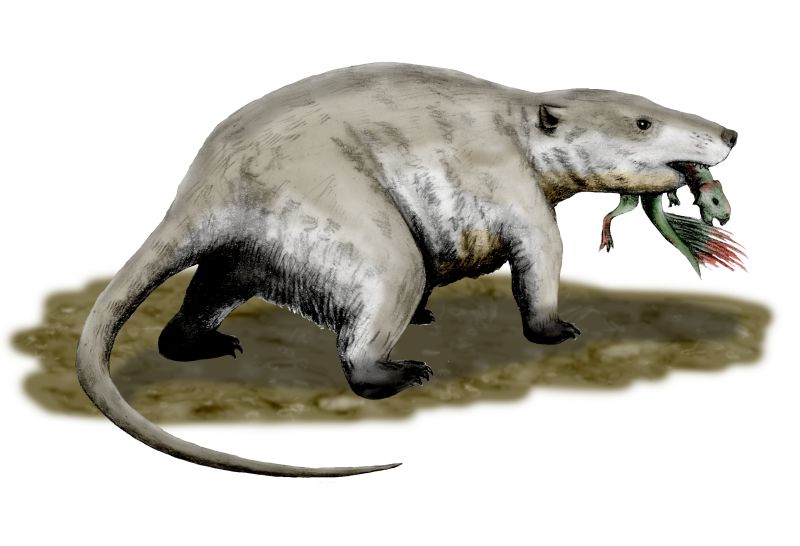- Repenomamus
Taxobox
name = "Repenomamus"
fossil_range =Early Cretaceous

image_width = 240px
regnum =Animal ia
phylum =Chordata
classis =Mammal ia
ordo =Triconodonta
familia = Repenomamidae
familia_authority = Li, Wang, Wang, Li,2000
genus = "Repenomamus"
genus_authority = Li, Wang, Wang, Li,2000
subdivision_ranks =Species
subdivision = "Repenomamus robustus"
Li, Wang, Wang, Li, 2000
"Repenomamus giganticus"
Hu, Meng, Wang, Li, 2005"Repenomamus" is the largest
mammal known from theCretaceous period of theMesozoic , and it is the mammal for which there is the best evidence that it fed ondinosaur s. It is not possible to determine if "Repenomamus" actively hunted livedinosaur s or scavenged dead dinosaurs."Repenomamus" was probably not a fast runner. The
humerus andfemur left their joints at a somewhat splayed angle, and the legs were relatively short compared to the body. The feet wereplantigrade . "Repenomamus"'s behavior and overall body shape may have resembled those of modern dayTasmanian devil s.Repenomamus was carnivorous. A specimen of "R. robustus" has been discovered with the fragmentary skeleton of a juvenile "
Psittacosaurus " preserved in itsstomach . This the strongest evidence thatMesozoic mammals fed ondinosaur s, and this created interest in the popular press. There were, however, earlier indications that Mesozoic mammals fed on dinosaurs (see "Archaeornithoides ").Elzanowski, Andrzej, Wellnhofer, Peter. (1993) "Skull of "Archaeornithoides" from the Upper Cretaceous of Mongolia" "American Journal of Science" Vol. 293-A-A, pp.235-252]Size of a small dog
The larger
species , "R. giganticus", holds the distinction of being the largest mammal known from the Cretaceous. A few other described mammals, such as an early giantplatypus , "Kollikodon ", may have been larger, but they are only known from small fragments so their actual size is in question. "R. giganticus" was more than 1 meter (39 inches) long and weighed about 12–14 kg (26–31 lb). Its skull measures 16 centimetres long, its body 52 cm, and the preserved part of its tail 36 cm. The other species, "R. robustus", was less than 0.5 m (20 in) long and weighed 4–6 kg (9–13 lb). These finds are considered important, because they expand theecological niche s known to be inhabited by mammals during the 150 million year reign of the dinosaurs. Previously, the only known mammals of this time period were small nocturnalinsectivore s, not unlike modern-dayshrew s. It had been assumed that the niches of animals larger than 1 meter (39 inches) in length were filled entirely by dinosaurs and reptiles like crocodilians, and were off limits to mammals until after theCretaceous-Tertiary extinction event wiped out the dinosaurs and allowed the diversification of mammals during theCenozoic . "Repenomamus" was an exception to this rule."R. giganticus" is larger than a number of species of
feathered dinosaurs also from the same rock formation in China, including "Microraptor ", "Sinornithosaurus ", "Caudipteryx " and "Mei ".Classification and discovery
The fossils were recovered from the lagerstätte of the
Yixian Formation in the Liaoning province of China, which is renowned for its extraordinarily well-preserved fossils offeathered dinosaurs . They have been specifically dated to 130million years ago , during theEarly Cretaceous period."Repenomamus" is a
genus oftriconodont s, a group of earlymammal s with no modern relatives. "R. robustus" was described by Li, Wang, Wang and Li in 2000, and "R. giganticus" was described by Hu, Meng, Wang, Li 2005. The two knownspecies are the sole members of the family Repenomamidae, which was also described in the same paper in 2000.References
*cite journal |author=J. Li, Y. Wang, Y. Wang, & C. Li |year=2001 |month= |title=A new family of primitive mammal from the Mesozoic of western Liaoning, China |journal=Chinese Science Bulletin |volume=46 |issue=9 |pages=782–785 |id= |url=http://dml.cmnh.org/2001May/msg00969.html |accessdate= |quote= |doi=10.1007/BF02900425
*cite journal |author=Yaoming Hu, Jin Meng, Yuanqing Wang, Chuankui Li |year=2005 |month= |title=Large Mesozoic mammals fed on young dinosaurs |journal=Nature |volume=433 |issue= |pages=149–152 |doi=10.1038/nature03102 |url= |accessdate= |quote=ee also
*
Mammaliformes
*Cynodont s
* "Cynognathus "
*Evolution of mammals External links
* " [http://www.nature.com/news/2005/050110/full/050110-11.html Prehistoric badger had dinosaurs for breakfast] ". Michael Hopkin. "Nature.com". January 12, 2005.
* " [http://news.bbc.co.uk/2/hi/science/nature/4165973.stm Fierce mammal ate dinos for lunch] ". "BBC News". January 12, 2005.
Wikimedia Foundation. 2010.
